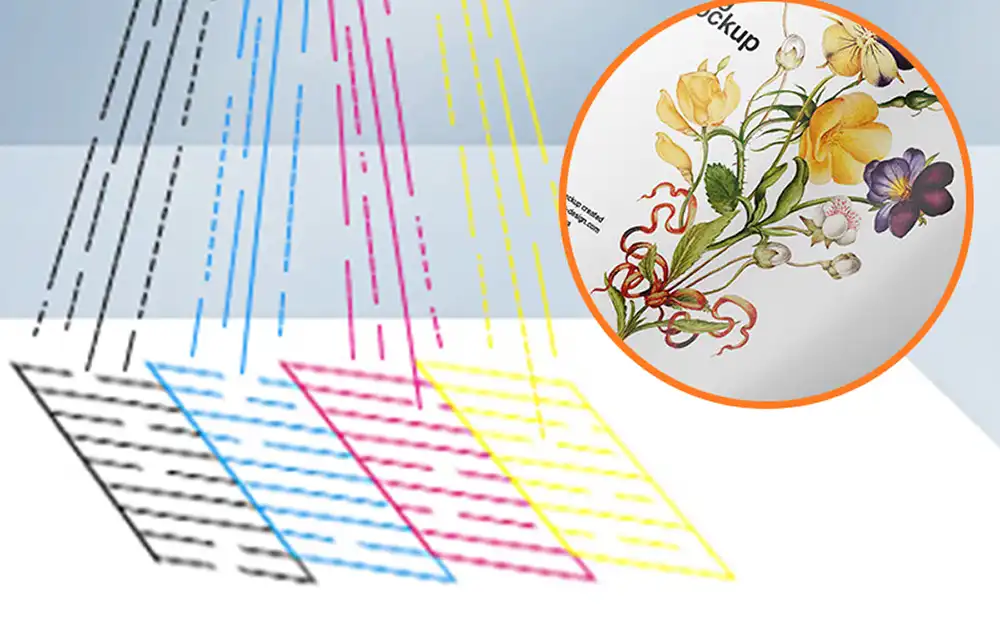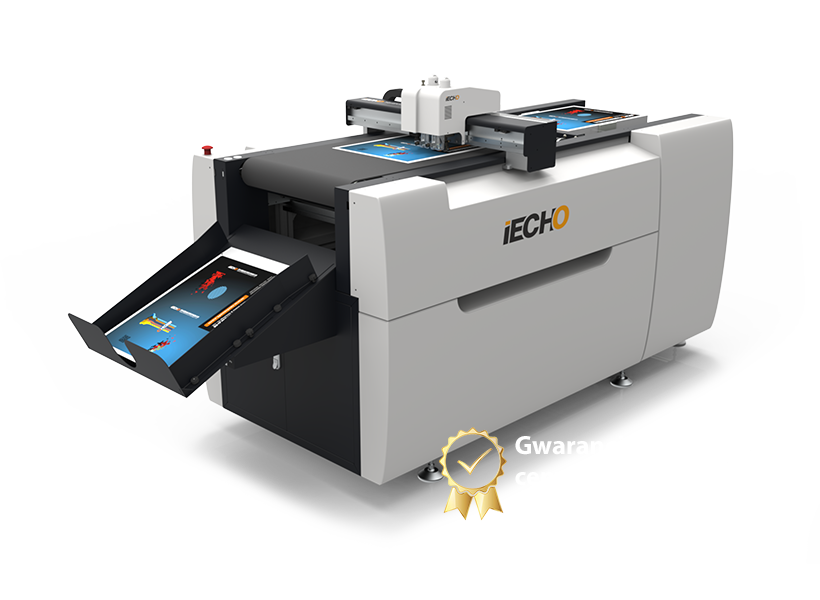UV printing is a technology that is fundamentally changing the face of modern printing. In an era where speed of turnaround competes with quality of workmanship, and customers expect durable solutions on non-standard materials, UV printing appears to be the answer to all these challenges simultaneously. The technology, which uses ultraviolet light to instantly cure special polymer inks, not only speeds up production, but opens up entirely new application possibilities - from glass to metal to wood and ceramics.
The real revolution, however, lies not only in the versatility of applications, but above all in the economy of the process. Prints ready for further processing in a fraction of a second after leaving the plotter, elimination of costly lamination processes, the possibility of printing in white color on dark substrates - these are just some of the advantages that make the investment in UV technology pay off in record time. For printers, this means the ability to accept orders impossible to fulfill with traditional methods, and thus access to new, high-margin market segments.
What is UV printing and how the technology works
UV printing is an advanced digital printing technology that uses specialized polymer inks cured by ultraviolet light. Unlike traditional methods, where the ink dries by absorbing or evaporating solvents, in UV technology there is instant polymerization - the transformation of liquid ink into a hard, resistant layer resembling thin plastic film.
The UV printing process begins similarly to a standard inkjet printer - the print heads precisely apply ink droplets to the surface of the material. The key difference occurs when the ink comes into contact with the substrate. The UV LED lamps integrated into the heads emit ultraviolet light of an appropriately selected wavelength, which initiates the instantaneous polymerization process. In a fraction of a second, the liquid polymer transforms into a cured, flexible coating with exceptional adhesion to the substrate.
This technology eliminates the main limitations of traditional printing. No drying means that prints are immediately ready for further processing - cutting, creasing or mounting. What's more, the cured UV ink forms a layer that is resistant to abrasion, water, UV radiation and most chemicals, making the prints virtually indestructible under standard use conditions.
Durability of UV printing - facts versus myths
The question about the durability of UV printing is one of the most frequently asked by potential users of this technology. The answer is clear - properly executed UV printing outlasts most other printing techniques in durability, offering resistance measured in years, not months.
Weather resistance is the key advantage of UV technology. Prints made with this method easily withstand exposure to rain, snow, frost or intense sunlight. In accelerated aging tests simulating years of outdoor use, UV prints retain more than 90% of color intensity after a period equivalent to 5-7 years of exposure. By comparison, standard solvent prints under similar conditions show significant fading after just 2-3 years.
Mechanical resistance UV printing is also impressive. The cured polymer layer is flexible, allowing it to withstand bending and stress without cracking. Abrasion tests show that the UV print can withstand more than 10,000 rubbing cycles without visible damage, while latex prints begin to show signs of wear after just 3,000-5,000 cycles.
However, it is worth a fair mention of the limitations. UV printing on extremely flexible materials can have a tendency to crack when stretched repeatedly above 150%. This problem is solved by special formulations of flexible inks, available in professional UV printing systems.
UV printing applications in various industries
The versatility of UV printing makes it applicable in almost every sector of the economy. Advertising industry uses this technology to produce high-quality signs, message boards, POS displays and all kinds of outdoor and indoor signage. The ability to print on materials such as dibond, Plexiglas or glass opens unlimited creative possibilities.
Interior decoration sector has discovered in UV printing a tool for creating unique design solutions. UV-printed glass panels are replacing traditional tiles in kitchens and bathrooms, offering unlimited possibilities for personalization. Printing on MDF or HDF allows the creation of furniture with any design, from imitations of exotic wood to abstract artistic compositions.
Packaging industry appreciates UV printing for its ability to print directly on packaging without the need for labels. This not only saves costs, but also enables innovative designs that take advantage of material transparency or special effects. Especially in the premium packaging segment, where every detail counts, UV printing has become a standard.
Electronics and automotive industry uses the precision of UV printing to mark components, create control panels or decorate vehicle interiors. Resistant to temperatures and chemicals, the prints remain legible throughout the life of the device.
Materials ideal for UV printing
One of the biggest advantages of UV technology is the ability to print on virtually any flat material. Glass and mirror are particularly graceful substrates - UV printing makes it possible to create striking decorative panels, glass with privacy graphics or mirrors with decorative elements. The use of white ink as an undercoat makes it possible to obtain vivid colors even on dark glass.
Plastics All types - from PVC to Plexiglas (PMMA) to polycarbonate - work well with UV inks. Rigid foamed PVC sheets are ideal for signage production, while transparent Plexiglas allows the creation of backlit advertising elements with exceptional image depth.
Wood and wood-based materials gain new life with UV printing. Raw wood, plywood, MDF, HDF or OSB can be printed without priming. This opens up possibilities in the production of furniture, interior design elements or premium packaging with natural character.
Metals - aluminum, stainless steel, brass - are also suitable for UV printing, although they may require appropriate surface preparation. Nameplates, prestige signs or decorative elements made with this technology are characterized by elegance and durability impossible with other methods.
Economic and environmental advantages of UV printing
Investment in UV technology brings tangible economic benefits. Elimination of additional processes such as lamination or varnishing means saving not only materials, but most importantly time. An order that by traditional methods would require 24-48 hours to complete (including drying time), using UV printing can be ready within an hour.
Waste reduction is another economic aspect. The lack of need for transfer films, the elimination of defects caused by dust adherence during drying, and the ability to print on demand in exact quantities minimize material waste. It is estimated that switching to UV technology can reduce production waste by 30-40%.
Environmental aspect UV printing is often underestimated. UV inks do not contain volatile organic compounds (VOCs), which are characteristic of solvent inks. Modern LED UV lamps contain no mercury and have low energy consumption with a lifetime of up to 20,000 hours of operation. The lack of emission of harmful fumes makes UV technology suitable for use in rooms without special ventilation.
Ability to produce on demand reduces the need to store finished products. Personalization and short runs become economically viable, which is in line with modern market trends oriented toward individualization and reducing mass production.
Technical parameters affecting quality
The quality of UV printing depends on a number of technical parameters, understanding of which is key to achieving optimal results. Print resolution in modern UV plotters reaches 1440 dpi, allowing reproduction of fine detail and smooth tonal transitions. For most commercial applications, a resolution of 720 dpi is fully sufficient, offering an ideal balance between quality and production speed.
Variable droplet technology used in professional systems allows dynamic adjustment of ink droplet size from 3 to 30 picoliters. Smaller droplets are used for reproducing details and smooth gradients, while larger droplets are used to quickly cover uniform surfaces. This is key to achieving both high quality and production efficiency.
Ink circulation system in advanced UV plotters prevents pigment sedimentation, particularly important in white ink. Continuous circulation ensures color stability and eliminates nozzle clogging problems, resulting in production reliability and reduced service downtime.
Temperature control during the printing process is critical for ink adhesion. Professional systems are equipped with heated work tables that optimize the substrate temperature, ensuring ideal adhesion and eliminating problems with deformation of thermoplastic materials.
The future of UV technology in printing
The development of UV printing technology is proceeding at a dizzying pace. Integration with IoT systems allows remote monitoring of printing parameters, predictive maintenance and optimization of material consumption. Printers can track the real-time performance of each device, predict failures and schedule maintenance at times of lowest production load.
Development of functional inks opens up entirely new areas of application. Conductive inks make it possible to print electronic circuits, thermochromic inks change color depending on temperature, and antimicrobial inks are used in the production of signage for medical facilities. This is just the beginning of the possibilities presented by the combination of UV technology and modern materials.
Automation of production processes goes hand in hand with the development of printing technology. Integrated workflow systems allow automatic processing of orders from online ordering, preflight, printing, finishing and shipping. Artificial intelligence optimizes job distribution, minimizing material consumption and maximizing machine utilization.
Market trends indicate a growing demand for personalization and small batch production. UV printing fits perfectly into these trends, offering cost-effective production of even single copies while maintaining mass production quality.
Bottom line - is it worth investing in UV printing?
UV printing is not just a printing technology - it is a strategic tool for business development in the printing industry. The versatility of applications, exceptional durability of prints, the ability to work on a variety of materials, as well as economic and environmental aspects, make investment in this technology not so much an option as a necessity for companies wishing to remain competitive.
For printers, this means the opportunity to enter new, high-margin market segments - from exclusive home decoration to industrial signage. The elimination of time-consuming finishing processes translates into the ability to fulfill express orders, which in the era of e-commerce and expectations of immediate fulfillment is becoming a key competitive advantage.
Looking ahead, UV printing will evolve to become even more automated, integrated with production management systems and develop new applications. Companies that invest in the technology today and gain experience using it will be best prepared to take advantage of the opportunities that the future of digital printing will bring. In the context of increasing demands for durability, personalization and speed of delivery, UV printing appears not as one option, but as the foundation of the modern print shop.


